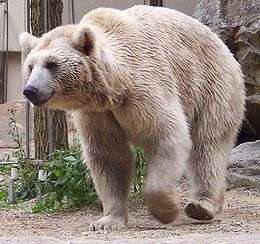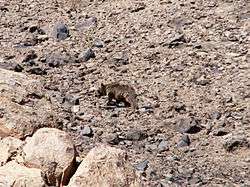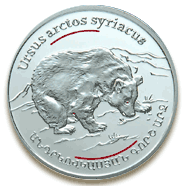Syrian brown bear
| Syrian brown bear | |
|---|---|
 | |
| Scientific classification | |
| Kingdom: | Animalia |
| Phylum: | Chordata |
| Class: | Mammalia |
| Order: | Carnivora |
| Family: | Ursidae |
| Genus: | Ursus |
| Species: | U. arctos |
| Subspecies: | U. a. syriacus |
| Trinomial name | |
| Ursus arctos syriacus | |
| Distribution | |
| Synonyms | |
|
caucasicus Smirnov, 1919 | |
The Syrian brown bear (Ursus arctos syriacus) is a relatively small subspecies of brown bear native to the Middle East.[1]
Evolutionary history
A genetic study shows that all brown bears occurring in the Caucasus at least matrilineally are monophyletic and belong to the Eurasian brown bear (Ursus arctos arctos).[2]
Characteristics
The Syrian brown bear's fur is usually very light brown and straw-coloured. The hair on the withers is longer with a grey-brown base and is often a different shade from the rest of the body, seen in some individuals as a dark stripe running across the back. The lighter colors usually appear at higher altitudes. Their legs are commonly darker than the rest of their body. It is the only known bear in the world to have white claws. It is a rather small brown bear. Adult males have skulls measuring approximately 30–40 cm (12–16 inches). The Syrian brown bear weighs up to 550 lb (250 kilograms), and measures from 101–140 cm (40–55 inches) from nose to tail.
Populations in the Caucasus were thought to belong to Ursus arctus syriacus and to overlap those of the Eurasian brown bear. They are larger in size and darker. In the past, some naturalists proposed that Caucasian bears belonged to hybrid populations between Eurasian and Syrian brown bears, but results of genetic studies show that all populations in the Caucasus are Eurasian brown bears.[2] It was thought that these mixed bears originated during the Holocene when Syrian bears supposedly migrated northward and interbred with the larger northern bears. Today that hypothesis is considered by experts as wrong.
Distribution and habitat

Historically, the Syrian brown bear occurred in the Middle East from Turkey to Turkmenistan.[3][4] Today, the brown bear is extirpated in Jordan, Israel and the Palestinian Territory, and survives only in Turkey, Iran and Iraq.[5] In Syria, brown bear tracks were recorded in the snow in the Anti-Lebanon Mountains in 2004 for the first time in five decades. In February 2011, bear tracks were again recorded in this area.[6]
In Turkey, important habitats are Mediterranean belt forests, deciduous and conifer forests in the Black Sea region and northeastern Turkey, oak and pine forests in the hinterlands of the Black Sea, and dry forests in East Anatolia. In elevation, these habitats range from 500 to 2,700 m (1,600 to 8,900 ft).[7] In Iran, it is present in the Central Alborz Protected Area south of the Caspian Sea and in the Zagros Mountains.[8] In these regions, it prefers higher altitudes and northern aspects with access to water resources.[9]
Ecology and behaviour
Litter size ranges from one to three cubs.[8]
Threats
In Turkey, the brown bear is threatened by large-scale forest fragmentation, degradation of habitat, and persecution in areas where it damages beehives and livestock. Local people in the Black Sea region hunt bears illegally for bear fat, which is thought to have medicinal value. Occasionally, bears are killed during hunts for wild boar using dogs, and by poisoned baits and snares set illegally for red deer, roe deer, wolf or lynx.[7]
In culture

The Syrian brown bear is the bear mentioned in the Bible. The protectiveness of a mother bear towards her cubs is cited proverbially three times (2 Sam. 17:8; Prov. 17:12; Hos. 13:8) in the Hebrew Bible.[10]
Among the huge variety of troops serving at Monte Cassino, probably the strangest was a bear from Iran, called Wojtek. Raised by and enlisted into the 22nd Artillery Supply Company of the Polish II Corps, he carried artillery shells during battle.[11]
References
- ↑ Masseti, M. (2009). Carnivores of Syria In: E. Neubert, Z. Amr, S. Taiti, B. Gümüs (eds.) Animal Biodiversity in the Middle East. Proceedings of the First Middle Eastern Biodiversity Congress, Aqaba, Jordan, 20–23 October 2008. ZooKeys 31: 229–252.
- 1 2 Murtskhvaladze, M.; Gavashelishvili, A.; Tarkhnishvili, D. (2010). "Geographic and genetic boundaries of brown bear (Ursus arctos) population in the Caucasus". Molecular Ecology. 19: 1829–1841. doi:10.1111/j.1365-294X.2010.04610.x. PMID 20345670.
- ↑ Calvignac, S., Hughes, S. and Hänni, C. (2009). "Genetic diversity of endangered brown bear (Ursus arctos) populations at the crossroads of Europe, Asia and Africa" (PDF). Diversity and Distributions: 1–9.
- ↑ Hatt, R. T. (1959). The mammals of Iraq (PDF). Ann Arbor: Museum of Zoology, University of Michigan.
- ↑ McLellan, B. N.; Proctor, M. F.; Huber, D.; Michel, S. (2017). "Ursus arctos". IUCN Red List of Threatened Species. Version 2017-3. International Union for Conservation of Nature.
- ↑ Garshelis, D.L., Steinmetz, R., Hajjar, I., and Tabbaa, D. (2015). "Brown bear(s) do exist in Syria: fuzzy photo generates much interest". International Bear News 24 (1): 5−8.
- 1 2 Can, Ö. and Togan, İ. (2004). "Status and management of brown bears in Turkey". Ursus 15 (1): 48−53.
- 1 2 Nezami, B. and Farhadinia, M.S. (2011). "Litter sizes of brown bears in the Central Alborz Protected Area, Iran". Ursus 22 (2): 167−171.
- ↑ Ataei, F., Karami, M. and Kaboli, M. (2012). "Summer Habitat Suitability Modeling of Brown Bear (Ursus arctos) Southern Alborz Protected Area". Iranian Journal of Natural Resources 65 (2): 235−245.
- ↑ George Cansdale, "Bear", in Merrill C. Tenney (ed.), The Zondervan Encyclopedia of the Bible, Vol. 1 (Zondervan, 2010).
- ↑ Orr, Aileen (1 November 2010). Wojtek the Bear – Polish War Hero. Birlinn Publishers. p. 45. ISBN 978-1-84158-845-2.
External links
| Wikimedia Commons has media related to Ursus arctos syriacus. |
| Wikispecies has information related to Ursus arctos syriacus |